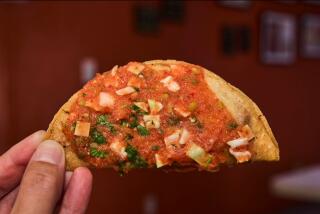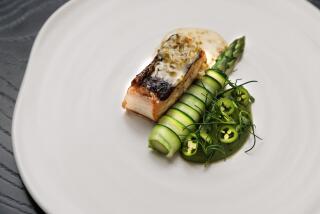Barcelona Putting Its Best Face Seaward
The artist/designer Mariscal, who is sort of the Keith Haring-cum-George Herriman of Barcelona, with touches of Andy Warhol and David Hockney thrown in, is famous for a visual pun he created on the city’s name: The syllable “Bar” is written in letters filled in with images of stools, a countertop, glassware and bottles--the trappings of a cocktail bar; “cel,” the Catalan word for “sky,” is done in clouds above a skyline, against celestial blue; “ona,” Catalan for “wave,” depicts a hectic beachfront scene. Mariscal likes to say that the image represents his city’s greatest virtues--its active bar and cafe life, its pleasant climate, and its proximity to the Mediterranean.
The image is memorable--but that last part, about the Mediterranean, isn’t entirely accurate. Though Barcelona is almost literally lapped by Mediterranean waters, and has been a great maritime capital for centuries, it has not, in recent years, paid much intimate attention to its beaches and waterfront. The sand is dirty; public facilities are few; the piers and quays are the province of fishermen, longshoremen, and wharf rats--not just plain folks. It has been said that although Barcelona abuts the sea, it turns its back to it.
Today all this is changing. In redeveloping and sprucing up itself for the forthcoming 1992 Olympic Games, Barcelona has started paying particular attention to its shoreline, and seems determined to make the piers and quays and beaches into something of a seaside showplace in the coming years. And, as it happens, Mariscal himself has at least a small part in the proceedings.
The first palpable manifestation of the new Barcelona waterfront is the Moll de la Fusta. The name literally means the “Wooden Jetty”--but it isn’t made of wood, nor does it extend out into the water. Instead, it’s a kind of balcony overlooking a new, well-lit harborside promenade--a long, elevated strip of stone and concrete with a semi-exposed parking lot underneath, trelliswork overhead, arrangements of tiled benches here and there, a couple of impressive-looking footbridges to the quay--and a row of casual bars and restaurants that give both life and focus to the structure (and simultaneously provide a comfortable place to perch while observing same).
The Moll’s shell was designed by local architect Sola Morales. Other designers have worked on the interiors of the five edicules or small buildings that house the eating and drinking establishments. The first one of these, starting from the south, at the bottom of the city’s famous Ramblas, is a casual and attractively raucous bar called Distrito, with serious rock music on the sound system and frivolous cocktails dispensed both inside and out. The next place is Blau Mari (“Navy Blue”). This is a casual, breezy restaurant, serving a combination of simple fish dishes (grilled hake, grilled spiny lobster, roasted sea bass, etc.) and Catalan specialties--including the fish stew called suquet and the ubiquitous pa amb tomaquet, which is bread rubbed with tomatoes and olive oil, served here with plump, delicious Costa Brava anchovies.
The next edicula houses a slightly more elegant-looking place called the Brasserie del Moll. This is, as its appearance would suggest, the most ambitious restaurant of the bunch. Among the specialties are duck foie gras from the Ampurdan region of northeastern Catalonia (served simply in terrine form, and flavorful enough though not as delicate as most French foie gras), deep-fried calamares (which for some reason are always described as “Roman-style” in Spain), a slightly busier version of suquet than Blau Mari’s, and the classic Catalan ragout of chicken and saltwater crayfish. The food isn’t bad here, but there are a dozen better restaurants within a few blocks’ walk, and the modest intentions of Blau Mari seem somehow more appropriate to this informal seaside setting.
The fourth edicula of the Moll de la Fusta contains a bar which, as far as I can tell, has no name and no particular distinguishing characteristics.
And then--in case you were starting to wonder whatever happened to Mariscal--there’s Gambrinus. You can see it coming from a long way off. The “Gambrinus” for whom the place is named is one of Mariscal’s comic-strip characters--a lobster with a plush-toy outline and an amiable smirk--and an immense papier-mache-look model of Gambrinus, dozens of feet long, clings to the roof, the smirk heroic in proportion. Mariscal designed the whole restaurant, too, and it’s about as much fun to sit in--or rather to sit outside of, since its large terrace is where nearly everybody parks themselves if the weather is halfway decent (which it usually is)--as any place in Barcelona. The tables are mostly portmanteau affairs that can be split open and rearranged every which way, depending on the size of the party. The chairs are Mariscal embellishments of simple metal cafe designs--with metal cutouts of fish, stars, cartoon body parts, and such welded onto them. The oversized white canvas umbrellas overhead are covered with Mariscalian fantasies--doodles and flowers, squiggles and beasts.
The food, unfortunately, doesn’t quite measure up to the surroundings. The proprietors of Gambrinus own a better-than-average seafood restaurant a bit further inland, on the avinguda Diagonal--but, ironically, they don’t seem to do as well down by the seaside. (One of his fellow designers told me that even Mariscal himself, when he comes down to Gambrinus on business, has lunch at Blau Mari.) The paella and various grilled fishes are about average here, and the oysters not quite that. But for sustenance while enjoying the decor and the passing scene, there’s nothing wrong at all with the pa amb tomaquet (with either ham or anchovies) or the pescadito frito (mixed fried baby fish), washed down with good beer (i.e., Spain’s own Damm or Spanish-brewed San Miguel) or a tall, thin coupe of cava-- the Catalan version of champagne. The lobster croquettes are also very good, incidentally--but how can anyone eat lobster with Gambrinus himself looming overhead, smiling guilelessly?
More to Read
The biggest entertainment stories
Get our big stories about Hollywood, film, television, music, arts, culture and more right in your inbox as soon as they publish.
You may occasionally receive promotional content from the Los Angeles Times.










